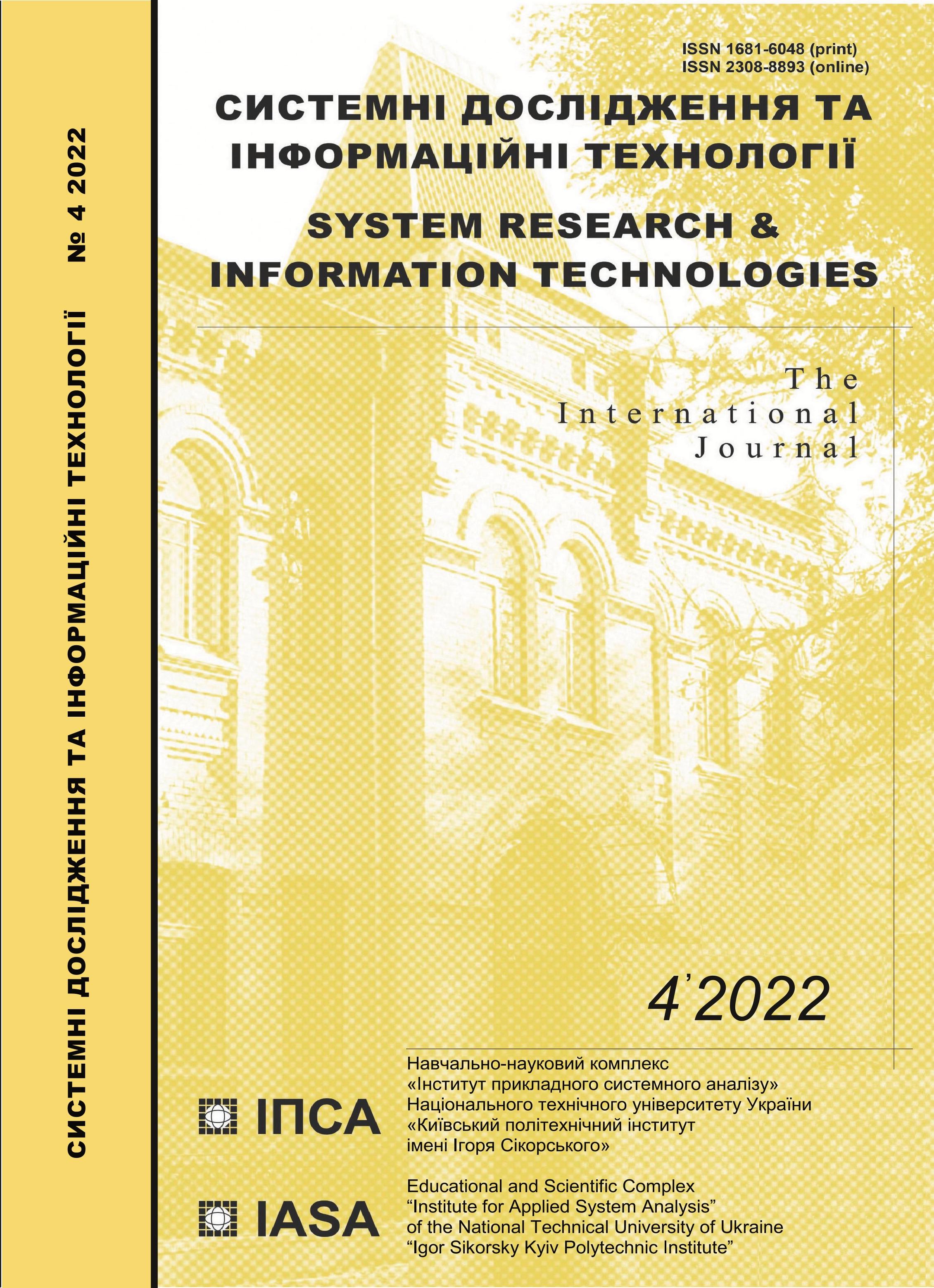On some methods for solving the problem of power distribution of data transmission channels taking into account fuzzy constraints on consumption volumes
DOI:
https://doi.org/10.20535/SRIT.2308-8893.2022.4.08Keywords:
data transfer, power distribution, fuzzy constraints, optimal solution, backtracking algorithmAbstract
The article deals with the mathematical formulation of the problem of optimal distribution of the power of data transmission channels in information and computer networks with a three-level architecture and fuzzy restrictions on consumption volumes. An efficient algorithm has been developed for solving the problem, the peculiarity of which is the inability to meet the end user’s needs at the expense of the resources of different suppliers. A standard solution method based on a fuzzy optimization problem of mathematical programming is considered. A constructive variant of finding a solution based on the backtracking method is proposed. Computational experiments have been carried out. The developed approach was used to determine the optimal configuration of a three-level information and computer network with a given number of communication servers.
References
L.G. Afraimovich and M.Kh. Prilutskii, “Multiindex Resource Distributions for Hierarchical Systems,” Automation and remote control, vol. 67, no. 6, pp. 1007–1016, 2006.
M.Kh. Prilutskii, “Many-Criteria Distribution of a Homogeneous Resource in Hierarchical Systems,” Automation and Remote Control, no. 2, pp. 24–29, 1996.
M.Kh. Prilutskii, “Distribution of a Homogeneous Resource in Tree-Structured Hierarchical Systems,” Proc. III Int. Conf. Identification of Systems and Control Problems (SICPRO’2000), pp. 2038–2049.
M.Kh. Prilutskii and A.G. Kartomin, “Flow Algorithms for Allocation of Resources in Hierarchical Systems,” Investigated in Russia, 39, pp. 444–452, 2003. Available: http://zhurnal.ape.relarn.ru/articles/2003/039.pdf
A. Schrijver, Theory of Linear and Integer Programming. Wiley, 1998, 484 p.
E.G. Zhdanova, Schedule theory. M., 2000, 136 p.
D.W. Pentico, “Assignment problems: A golden anniversary survey,” European Journal of Operational Research, vol. 176, pp. 774–793, 2007. doi: 10.1016/j.ejor.2005.09.014.
E. Ivokhin and M. Makhno, “On an approach to construction of structured fuzzy sets and their application for description of fuzzy time response,” Journal of Automation and Information Science, 49(10), pp. 55–63, 2017. doi: 10.1615/JAutomatInfScien. v49.i10.60.
F.C.R. Spieksma, “Multi index assignment problems: complexity, approximation, applications,” Nonlinear Assignment Problems. Algorithms and Applications; P.M. Pardalos, L.S. Pitsoulis (Eds.). Dordrecht: Kluwer Academic Publishers, 2000, pp. 1–11. doi: 10.1007/978-1-4757-3155-2_1.
Y.Crama and F.C.R. Spieksma, “Approximation algorithms for three-dimensional assignment problems with triangle inequalities,” European Journal of Operational Research, vol. 60, pp. 273–279, 1992. doi: 10.1016/0377-2217(92)90078-N.
L.G. Raskin and I.O. Kirichenko, Multi-index problems of linear programming. M.: Radio and communication, 1982, 240 p.
J.B. Orlin, “A Faster strongly polynomial minimum cost flow algorithm,” Operations research, vol. 41, iss. 2, pp. 338–350, 1993. doi: 10.1145/62212.62249.
Z. Lukac, D. Hunjet, and L. Neralic, “Solving the production-transportation problem in the Petroleum Industry,” Revista Investigacion Operacional, vol. 29, iss. 1, pp. 63–70, 2008.
E. Ivokhin, D. Apanasenko, and V. Navrodskiy, “About production-transport problem reduction to the two-level problem of discrete optimization and its application,” Bulletin of Taras Shevchenko Nathional University of Kiev: Economics, no. 3(198), pp. 48–53, 2018. doi: 10.17721/1728-2667.2018/198-3/6.
L.A. Zadeh, “Fuzzy sets,” Information and Control, vol. 8, pp. 338–353, 1965. doi: 10.1016/S0019-9958(65)90241-X.
R.E. Bellman and L.A. Zadeh, “Local and fuzzy logics,” Modern Uses of Multiple-Valued Logics; edited by J.M. Dunn, G. Epstein, D. Reidel. Dordrecht-Holland, 1977, pp. 103–165. doi: 10.1007/978-94-010-1161-7_6
D. Dubois, “Linear programming with fuzzy data,” Analysis of Fuzzy Information; J.C. Bezdek (ed.). Boca Raton: CRC Press, 1987, vol. 3: Applications in Engineering and Science, pp. 241–263.
Bablu Jana and Tapan Kumar Roy, “Multi-Objective Fuzzy Linear Programming and Its Application in Transportation Model,” Tamsui Oxford Journal of Mathematical Sciences, 21(2), pp. 243–268, 2005.
H.J. Zimmermann, “Fuzzy programming and linear programming with several objective functions,” Fuzzy Sets and System, no. 1, pp. 45–55, 1978. doi: 10.1016/0165-0114(78)90031-3
D.B. Yudin and E.G. Golshtein, Linear programming. M.: Nauka, 1969, 424 p.
R.E. Bellman and L.A. Zadeh, “Decision making in a fuzzy environment,” Management Science, no. 17, pp. 141–164, 1970. doi: 10.1287/mnsc.17.4.B141.
O.F. Voloshin and S.O. Mashchenko, Models and methods for decision making. K.: “Kiev University”, 2010, 336 p.
D. Watson, A Practical Approach to Compiler Construction. Springer, 2017, 254 p.

